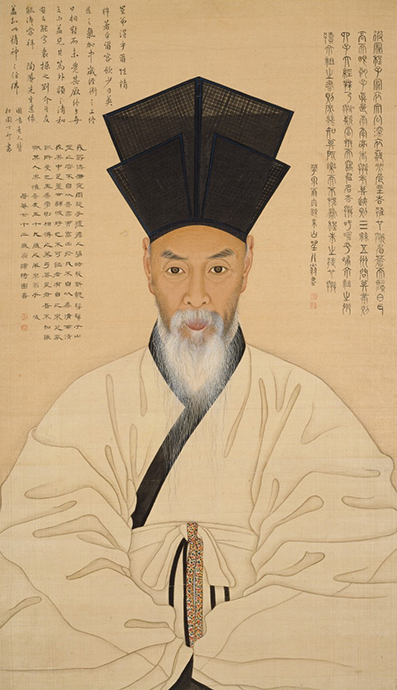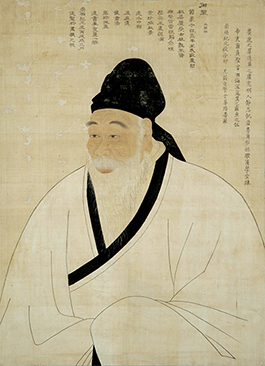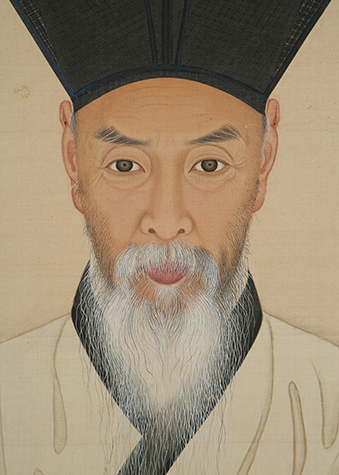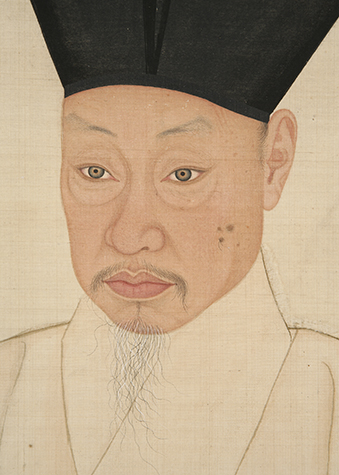- Date 2019-02-22
- Hit 2473
Portrait of Yi Chae depicts Yi Chae (李采, 1745-1820), the famed scholar of the late Joseon period, wearing a pointed dongpagwan hat and a simui, or “scholar’s robe” (white hemp robe with black trim). In this half-body portrait, Yi Chae stares straight out from the canvas, seated with impeccable posture.
Yi Chae: Scholar and Government Official
A member of the Ubong Yi clan, Yi Chae (李采, 1745-1820) was the grandson of Yi Jae (李縡, 1680-1746), the leading figure of the Noron faction. After passing the Licentiate Examination (司馬試) in 1774 (fiftieth year of the reign of King Yeongjo), Yi Chae became one of an influential scholar and civil official of the late Joseon Dynasty. His courtesy name was “Gyeryang” (季良), and he was posthumously given the name “Hwacheon” (華泉).
While serving as a Magistrate of Eumjuk County, Yi Chae was falsely accused and forced to resign. Thus, he returned home, dedicating himself to his studies and the family business. In 1790 (fourteenth year of the reign of King Jeongjo), Yi resumed his government service, rising to hold prestigious posts such as Hojochampan (戶曹參判, Second Minister of the Board of Taxation). His publications include the sixteen volumes of Collected Works of Yi Chae (華泉集).

Choice of Attire: Dongpagwan Hat and Simui (Scholar’s Robe)
Painted when Yi Chae was fifty-eight years old, this portrait depicts the venerate scholar in a pointed dongpagwan hat and a simui (or “scholar’s robe”), a white hemp robe with a straight black collar and black trim. Such robes served as the primary daily attire for scholars since the introduction of Zhu Xi’s Neo-Confucianism. Accompanying a simui robe, Joseon scholars usually wore a bokgeon (幅巾, black hat with rear flap) made from black silk. The distinct contrast between the white robe and black hat was intended to reflect the discipline and stature of a dignified scholar. The representative depiction of this outfit is Portrait of Song Siyeol, in which Song Siyeol, a devout Neo-Confucianist who vowed to abide by the principles of Zhu Xi, wears a white simui robe and bokgeon hat. Notably, Song Siyeol had chosen this outfit after studying Portrait of Zhu Xi (朱子像), in order to emphasize the austere aesthetics and to exemplify his status as a Neo-Confucian scholar dedicated to self-examination.

In Joseon portraits of Neo-Confucian literati, the choice of attire was an essential element that was intended to represent the sitter’s identity and aspirations. While some wished to emphasize their government service by being depicted in an official’s robe with a badge and belt representing their rank, others preferred to be clothed in plain daily robes, conveying their reverence for modesty and self-cultivation.
Like Song Siyeol, Yi Chae is dressed in a simui, but he chose to wear a pointed dongpagwan hat, rather than a bokgeon. Made from horsehair, pyramidal dongpagwan hats were commonly worn by literati scholars. They were named after “Dongpa” (東坡, Ch. Dongpo), which was the penname of Su Shi (蘇軾), a famous scholar of the Song Dynasty. The main body of these hats is shaped like an upside-down pyramid, with two smaller panels extending from the left and right, respectively.
The robe has a white band, tied just below the chest, adorned with black trim and a five-colored ribbon tied over the bow and hanging down. The addition of this colorful ribbon gives Portrait of Yi Chae a brighter and more decorative look than Portrait of Song Siyeol, which is characterized by its stark black and white contrast.
Pose and Posture: Full Frontal View
Looking directly at the viewer, Yi Chae demands our attention with his intense stare. With delicate yellow coloration around the eyes, his gaze is almost unnervingly vivid and lifelike. While there are a few other Joseon portraits featuring this straight-on pose, most works depict the sitter turned slightly to the right. As exemplified by this portrait and Self-portrait of Yun Duseo, a full-frontal pose helps to capture the determined self-examination of the sitter more directly, thus conveying a powerful impression to the viewers.
The portrayal of the face is quite striking, thanks in part to an adept use of “reverse coloring,” a characteristic technique of Joseon portraits. For “reverse coloring,” after the outlines of the figure are drawn on the front of the canvas, colors are applied to the reverse side of the canvas. The applied pigments are seen through the silk threads, creating more depth and subtler shading, as well as a clearer and cleaner skin tone on the face. As such, “reverse coloring” was widely embraced as a favored element of portraits of the Joseon literati.
After reverse coloring, short brushstrokes were added to the front to enhance the contour, dimension, and detail of the face and other features. The brushstrokes were also used for shading, with more strokes added to darken certain areas and fewer strokes applied in brighter areas. Furthermore, the contrast between the brighter areas (e.g., the nose, the eyebrows, and the space between the eyebrows) and the darker areas (e.g., the outline of the face) gives the face a highly three-dimensional look. In Portrait of Seo Jiksu, many brushstrokes were well blended, yielding a color tone reminiscent of pastels. In Portrait of Yi Chae, on the other hand, the individual brushstrokes are clearly discernible in certain areas, such as around the eyes. This is a later technique, indicating that Portrait of Yi Chae was produced after Portrait of Seo Jiksu. This portrait is also notable for the meticulous rendering of minute details, such as the slightly darkened age spots around his eyes, the scar on the bridge of the nose, and the varying shades of black in the overlapping layers of the hat.
Unlike the detailed depiction of the face, the folds in the robes are broadly rendered, mostly with lines. Once again, “reverse coloring” was used for the robe, with white pigment being applied to a wide area on the reverse side of the canvas. The shading around the folds was then painted on the front side. The colors of the five-color ribbon on the chest (i.e., black, white, red, blue, and yellow) were painted on the front, accentuating them and bringing a greater sense of vitality to this painting. While the staring face has a distinct three-dimensional quality, the planar body has a more relaxed appearance, with no sense of tension.
 Face from Portrait of Yi Chae.
Face from Portrait of Yi Chae.
 Face of Portrait of Seo Jiksu, Yi Myeonggi and Kim Hongdo, Joseon Dynasty (1796), Ink and colors on silk, 148.8 × 72.4cm
Face of Portrait of Seo Jiksu, Yi Myeonggi and Kim Hongdo, Joseon Dynasty (1796), Ink and colors on silk, 148.8 × 72.4cm
Inscriptions by Yi Chae and Friends
Three separate inscriptions appear on the painting: on the upper right, a commentary composed by Yi Chae himself, rendered in seal-script calligraphy by Yi Hanjin (李漢鎭, 1732-1815); on the lower left, an encomium composed by esteemed writer Yu Hanjun (兪漢雋, 1732-1811) in 1803, rendered in clerical-script calligraphy by Yu Hanji (兪漢芝, 1760-1834); and on the upper left, “Encomium of Old Man Wongyo,” rendered in running-cursive-script calligraphy by Kim Ido (金履度, 1750-1813) in 1807. Interestingly, although “Wongyo” was the penname of the renowned calligrapher Yi Gwangsa (李匡師, 1705-1777), “Old Man Wongyo” (圓嶠老人) is believed to refer to a different person with the same penname.
The inscription composed by Yi Chae himself is also included in the ninth volume of Collected Works of Yi Chae (華泉集) under the title of “Commentary on Portrait” (題眞像). The text of “Commentary on Portrait” (題眞像) indicates that the portrait was painted in or around the yimsul year (壬戌), which corresponds to 1802. The other two inscriptions, written in 1803 and 1807 (respectively), were apparently added after the portrait had been produced. Yi Chae’s inscription can be translated as follows:
Who is this person sitting with such dignity and prominence,
wearing the hat of Cheongzi and a scholar’s robe,
following the style prescribed by Master Zhu Xi?
Your eyebrows are dark, and your beard is white.
Your ears are long, and your eyes are bright.
Is this indeed the image of Yi Chae?
Looking back at your career, you governed three different counties and five different provinces.
As for your scholarship, you studied the Four Books and Six Classics.
But did you not cheat the present era and steal empty fame?
Ah! Return to your ancestral home
and read the writings of your grandfather, Yi Jae.
Only then will you perhaps be able to understand the meaning of life’s delight
and bring no shame to the followers of the Cheng-Zhu school.
Oddly, in this writing, Yi Chae states that he is wearing the “hat of Cheongzi” (程子, 1033-1107), the famous Song scholar, even though he is clearly wearing a pyramidal dongpagwan hat. Another style of hat that was also commonly worn by Joseon literati scholars in their houses, the “hat of Cheongzi” was characterized by two or three layers of protruding mountain-shaped panels.
In this full frontal portrait, Yi Chae stares straight ahead with both hands clasped in a white simui robe and black dongpagwan hat. In addition to his own inscription, in which he reflects on his life, the portrait also bears two more inscriptions written by his friends.
Uniting the arts of painting and literature, this work comprehensively represents the life and mind of Yi Chae in both image and text. Approaching the important age of sixty, Yi used this portrait to engage in intense self-contemplation, pondering his beliefs and identity and navigating his path into the future. As such, this remarkable portrait faithfully captures the essential nature of Yi Chae.






 X
X  Facebook
Facebook 